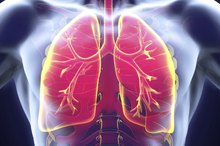The Effects of Tar in Smoking
When cigarette smoke is passed through a filter, it leaves a black, sticky substance known as tar. The exact composition of the tar that smokers inhale is uncertain. Any sort of plant material is a veritable witch’s brew of complex chemical compounds. Burning transforms these compounds in the tobacco leaves in an unpredictable manner, and the final composition of the inhaled smoke depends on exactly how a cigarette is smoked. While it’s hard to determine exactly what’s in tar, it’s clear that it causes most of the deleterious health effects of tobacco.
Lung Cancer
Lung cancer is one of the best-known diseases caused by smoking. Some known carcinogens that are usually found in tar include benzene, acrylamide and acrylonitrile. Smoking exposes the delicate cells inside the lungs directly to these compounds, causing mutations in the DNA of the cells and leading to cancer. According to the World Health Organization's report on "Tobacco Smoke and Involuntary Smoking," 90 percent of all cases of lung cancer are attributable to smoking.
- Lung cancer is one of the best-known diseases caused by smoking.
- According to the World Health Organization's report on "Tobacco Smoke and Involuntary Smoking," 90 percent of all cases of lung cancer are attributable to smoking.
Emphysema
The Effects of Nicotine on the Cardiovascular System
Learn More
Emphysema is a disease in which the complex honeycomb of air passages and pockets inside the lungs breaks down, leading to large open air spaces. These large spaces do not absorb oxygen from the air nearly as well as the original lung tissue, which leads to shortness of breath. It is also harder to push air out of the damaged lung tissue, which leads to increased effort in exhaling. Compounds in tar cause inflammation inside the lungs, which activates the cells of the immune system. Over time, the constant activity of these immune cells causes the breakdown of lung tissue and emphysema.
- Emphysema is a disease in which the complex honeycomb of air passages and pockets inside the lungs breaks down, leading to large open air spaces.
Heart Disease
Smokers have a much higher rate of coronary artery disease, CAD, than do non-smokers. Part of this increased risk is attributable to the nicotine in cigarettes, but tar also plays a significant role. Some of the compounds in tar are adsorbed through the lungs and enter the bloodstream. Once there, they promote a chemical transformation of the cholesterol in the blood that makes it much more likely to form plaques on the walls of arteries, including the coronary arteries. Smoking and high cholesterol are therefore multiplicative risk factors for CAD. Having both together is much worse than the sum of having them separately.
- Smokers have a much higher rate of coronary artery disease, CAD, than do non-smokers.
- Part of this increased risk is attributable to the nicotine in cigarettes, but tar also plays a significant role.
Related Articles
References
- Tobacco Smoke and Involuntary Smoking
- "Harrison’s Principles of Internal Medicine"; Dennis L. Kasper
- Centers for Disease Control and Prevention. What are the risk factors for lung cancer?. Updated September 18, 2019.
- Tindle HA, Stevenson Duncan M, Greevy RA, et al. Lifetime smoking history and risk of lung cancer: Results from the Framingham Heart Study. J Natl Cancer Inst. 2018;110(11):1201-7. doi:10.1093/jnci/djy041
- National Cancer Institute Division of Cancer Control and Population Sciences. Cancer stat facts: Lung and bronchus cancer. Updated 2020.
- Schane RE, Ling PM, Glantz SA. Health effects of light and intermittent smoking: a review. Circulation. 2010;121(13):1518-22. doi:10.1161/CIRCULATIONAHA.109.904235
- Centers for Disease Control and Prevention. Cancers linked to tobacco use make up 40% of all cancers diagnosed in the United States. November 10, 2016.
- Centers for Disease Control and Prevention. Smoking and tobacco use: Fast facts. Updated May 21, 2020.
- American Cancer Society. Harmful chemicals in tobacco products. Updated April 5, 2017.
- Torgovnick A, Schumacher B. DNA repair mechanisms in cancer development and therapy. Front Genet. 2015;6:157. doi:10.3389/fgene.2015.00157
- Li R, Ong SL, Tran LM, et al. Chronic IL-1β-induced inflammation regulates epithelial-to-mesenchymal transition memory phenotypes via epigenetic modifications in non-small cell lung cancer. Sci Rep. 2020;10(1):377. doi:10.1038/s41598-019-57285-y
- Tilley AE, Walters MS, Shaykhiev R, Crystal RG. Cilia dysfunction in lung disease. Annu Rev Physiol. 2015;77:379-406. doi:10.1146/annurev-physiol-021014-071931
- Yamaguchi NH. Smoking, immunity, and DNA damage. Transl Lung Cancer Res. 2019;8(Suppl 1):S3-S6. doi:10.21037/tlcr.2019.03.02
- Remen T, Pintos J, Abrahamowicz M, Siemiatycki J. Risk of lung cancer in relation to various metrics of smoking history: a case-control study in Montreal. BMC Cancer. 2018;18(1):1275. doi:10.1186/s12885-018-5144-5
- Mong C, Garon EB, Fuller C, et al. High prevalence of lung cancer in a surgical cohort of lung cancer patients a decade after smoking cessation. J Cardiothorac Surg. 2011;6:19. doi:10.1186/1749-8090-6-19
- Jha P, Ramasundarahettige C, Landsman V, et al. 21st-century hazards of smoking and benefits of cessation in the United States. N Engl J Med. 2013;368(4):341-50. doi:10.1056/NEJMsa1211128
- Cahoon EK, Preston DL, Pierce DA, et al. Lung, laryngeal and other respiratory cancer incidence among Japanese atomic bomb survivors: An updated analysis from 1958 through 2009. Radiat Res. 2017;187(5):538-548. doi:10.1667/RR14583.1
- Goel R, Bitzer ZT, Reilly SM, et al. Effect of charcoal in cigarette filters on free radicals in mainstream smoke. Chem Res Toxicol. 2018;31(8):745-51. doi:10.1021/acs.chemrestox.8b00092
- Funatogawa I, Funatogawa T, Yano E. Trends in smoking and lung cancer mortality in Japan, by birth cohort, 1949-2010. Bull World Health Organ. 2013;91(5):332-40. doi:10.2471/BLT.12.108092
- Alberg AJ, Brock MV, Ford JG, Samet JM, Spivack SD. Epidemiology of lung cancer: Diagnosis and management of lung cancer, 3rd ed: American College of Chest Physicians evidence-based clinical practice guidelines. Chest. 2013;143(5 Suppl):e1S-e29S. doi:10.1378/chest.12-2345
- Connolly GN, Alpert HR. Has the tobacco industry evaded the FDA's ban on 'light' cigarette descriptors?. Tob Control. 2014;23(2):140-5. doi:10.1136/tobaccocontrol-2012-050746
- Centers for Disease Control and Prevention. Bidis and kreteks. Updated January 17, 2018.
- Hecht SS. It is time to regulate carcinogenic tobacco-specific nitrosamines in cigarette tobacco. Cancer Prev Res (Phila). 2014;7(7):639-47. doi:10.1158/1940-6207.CAPR-14-0095
- Aslam HM, Saleem S, German S, Qureshi WA. Harmful effects of shisha: literature review. Int Arch Med. 2014;7:16. doi:10.1186/1755-7682-7-16
- Zhang LR, Morgenstern H, Greenland S, et al. Cannabis smoking and lung cancer risk: Pooled analysis in the International Lung Cancer Consortium. Int J Cancer. 2015;136(4):894-903. doi:10.1002/ijc.29036
- American Cancer Society. What do we know about e-cigarettes?. Updated January 7, 2020.
- U.S. Preventive Services Task Force. Lung cancer: Screening. July 07, 2020
Writer Bio
Sydney Hornby specializes in metabolic disease and reproductive endocrinology. He is a graduate of Claremont McKenna College and Drexel University College of Medicine in Philadelphia, where he earned his M.D., and has worked for several years in academic medical research. Writing for publication since 1995, Hornby has had articles featured in "Medical Care," "Preventive Medicine" and "Medical Decision Making."









